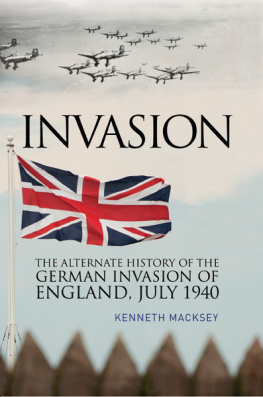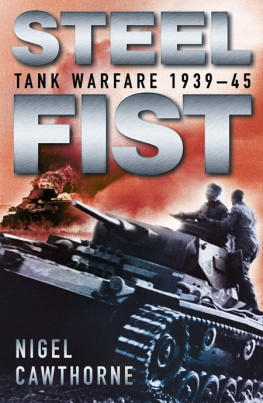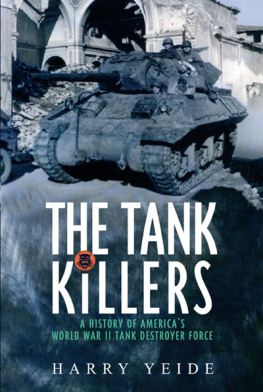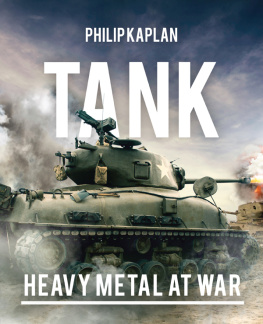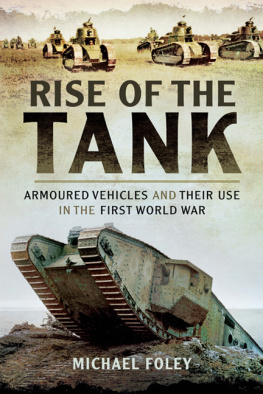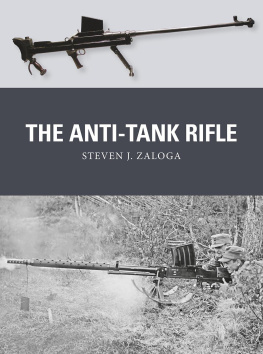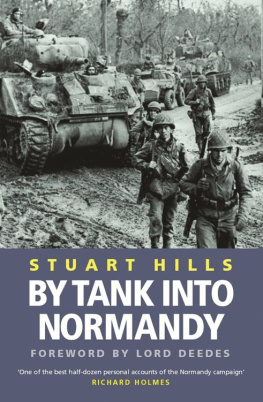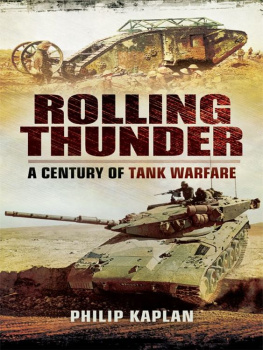BY THE SAME AUTHOR
Shadow of Vimy Ridge
Armoured Crusader: The Biography of Major-General Sir Percy Hobart
Crucible of Power The Fight for Tunisia
Tank A History of the Armoured Fighting Vehicles (with John Batchelor)
Rommel: Battles and Campaigns
Battle: Normandy 1944 Life and Death in the Heat of Combat
Guderian: Panzer General
DEFINITION
Strictly speaking, there has only ever been one tank, and that was the rhomboidal shaped, caterpillar-tracked machine which first went into action on 15 September 1916. Since then the shape has changed although the name has not. Caterpillar-tracked machines whether with their guns encased in rotating turrets, buried in fixed mountings within the hull or on open platforms above the hull have all at some time come to be known as tanks though to be accurate they were, respectively, main combat vehicles, armoured guns or self-propelled artillery. Thus, even when the rabid proponents or critics of so-called all-tank armies used that phrase they usually had in mind all-armoured mechanized armies including in them, for good measure, the unarmed but armoured infantry carrier.
In this book, for the same reason of convenience that has served in the past, the noun tank will sometimes be used in its looser sense but the reader is asked to remember the clear distinctions separating the various categories of armoured fighting vehicles.
PREFACE
From its inception the story of tank warfare has been dominated by emotion emotion in evolution and in narration. Not only did tanks revolutionize the art of war in less than a decade and set the military pundits at loggerheads, but the very association with modern battle and immense destruction of these symbolically brutal machines became the pacifists nightmare and the propagandists dream. Such has been the fascination of the tank that, with the possible exception of the fighting aeroplane, it can claim to have generated more literary endeavour than any new weapon. For tank warfare is a microcosm of war and therefore of life the reflection of mans struggle for survival incorporating the subtle, shifting nuances between defence and attack: aggression and regression.
It is hardly surprising, therefore, that accounts of the tanks progress have become enshrined in myth. A wholly objective view so close to events is impossible and the most reputable works on the subject are those written by men closely connected with tank development. Undeniably it was to the Tank Ideas advantage that its advocates were possessed of literary calibre and the propagandists art. Men such as Winston Churchill, Ernest Swinton, Albert Stern, G. le Q. Martel, J. F. C. Fuller, Basil Liddell Hart, Heinz Guderian and Charles de Gaulle, to name the most prominent, were the vital driving forces in pushing the tank into the forefront of military progress. But in telling their story it would have been surprising if, at times, they had not exhibited bias by emphasizing their successful contributions to the exclusion of their errors. Let us not be deluded into thinking that the literary outpourings of the tank pioneers are the products of absolute historic accuracy. For instance, there are contradictions between what Guderian wrote prior to 1939 and what he later recalled in his post-war and oft quoted book Panzer Leader . Similar discrepancies can be found among the successive works of Swinton, Fuller, Liddell Hart and all the others.
I have endeavoured to simplify a complex subject and reduce it as close to objectivity as possible without eliminating the drama. I take the view that tank warfare developed too quickly for mental digestion and that those who carped at the impediments to its meteoric career forgot how much slower had been the advancement of earlier revolutionary weapons: for example the machine-gun was 150 years from inception to production. I must also admit to a similar petulance myself on previous occasions while in no way rejecting the need for impatience in those who wish to inspire progress of any kind. There is always something new to learn and one can always be wrong. Contemporary history remains a hotbed of distortions.
In writing this book it has been my good fortune to come into possession of new material and much good advice, not only from those who were involved in the tank struggle but from the band of enthusiasts who have carried out recent research into the documents of the case. I refer particularly to Tim Nenninger, who compiled a formidable thesis on the subject of US Armor, and General Walter Nehring, whose recent book helps clarify the evolution of the German Tank Force and with whom I have had a rewarding correspondence. I am heavily indebted to Lieutenant-General Sir Charles Broad and Major-General Robert Grow for their memories and diaries giving insight into the formative days of, respectively, the British and US armoured forces; to General-Major Heinz Guderian for a fresh interpretation of his fathers writings; and to Herr Albert Speer for some shrewd judgments concerning Germanys struggle for tank survival in the Second World War.
To Colonel Peter Hordern, the Director of the Royal Armoured Corps Tank Museum, I am indebted not only for his help in guiding me through the archives of his incomparable establishment but also for reading and criticizing my first draft. And, as so often in the past, my deepest gratitude goes to the staff of the War Office Library particularly Mr Potts and Mrs Davies in making available so many important volumes for my study. The bibliography owes much to them.
Finally there are profound thanks to my Production Team to Michael Haine who drew the maps and diagrams, Helga Ashworth who translated German documents, Margaret Dunn who typed and criticized the manuscript and my wife who, as so often in the past, read proofs and encouraged me in moments of depression.
Kenneth Macksey
1971
CHAPTER 1
OVERTURE IN THE MUD
Three preposterous shapes stand silhouetted against thin patches of snow, and in the rising dawn become more plainly recognizable. They are tanks ready for battle. Between the armoured walls crews shiver and anxiously wait the decision being taken by the group of officers gathered close to the leading machine. Huddled nearby in shallow scrapes, dredged laboriously out of the stiff Artois mud, crouch the infantry. Ahead, but not yet visible in the gloom, stands the silent village of Monchy-le-Preux, German held and crowning the crest which dominates the local scene. This morning it has to be taken if the two-day-old British offensive is to make worthwhile progress. Zero hour for the coming attack is set for 5am, 11 April and it is nearly that already. But the tank commanders have heard, only this minute, that the artillery barrage which is intended to prepare the way has had to be postponed two hours; without it the infantry will not advance, for too frequently in the past they have been mown down in attacks put in without heavy gunfire. They have no reason to trust these tanks. Few in number and with barely six months experience in battle they are no reliable substitute for artillery.
Tanks cannot hug the ground. Remain here until daylight and they will present themselves as targets for the German gunners and will be shot to pieces. The tank commanders know they must move, but they cannot retreat ignominiously and there is no cover nearby. They can only advance to their front on their own and tackle the Germans single-handed. Switches are on, engines cranked into life, machine-guns cocked and the breeches of 6-pounder cannons clunked home behind the brass shell-cases. Three engines rev up with a splutter, tracks move, creak and rotate and the 30-ton creatures heave themselves up the slope towards Monchy. Here 200 German soldiers shelter in pill-boxes and in cellars, quaking in fear of tanks weapons of inexorable power which, on first acquaintance, seems to them invulnerable. As the three tanks blunder down the village streets the Germans run and Monchy has fallen.


